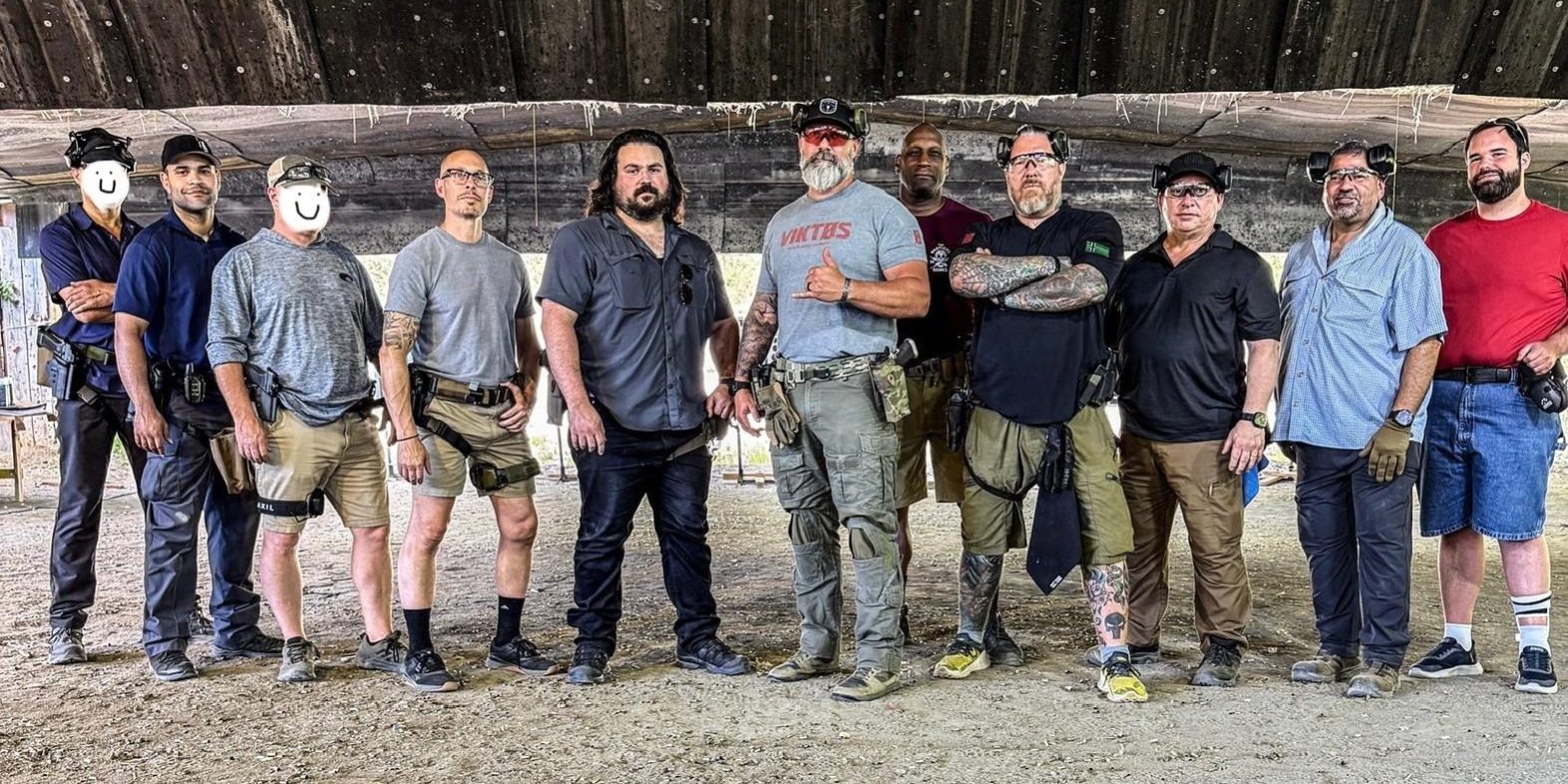[AAR]: RESTON RESTORATION
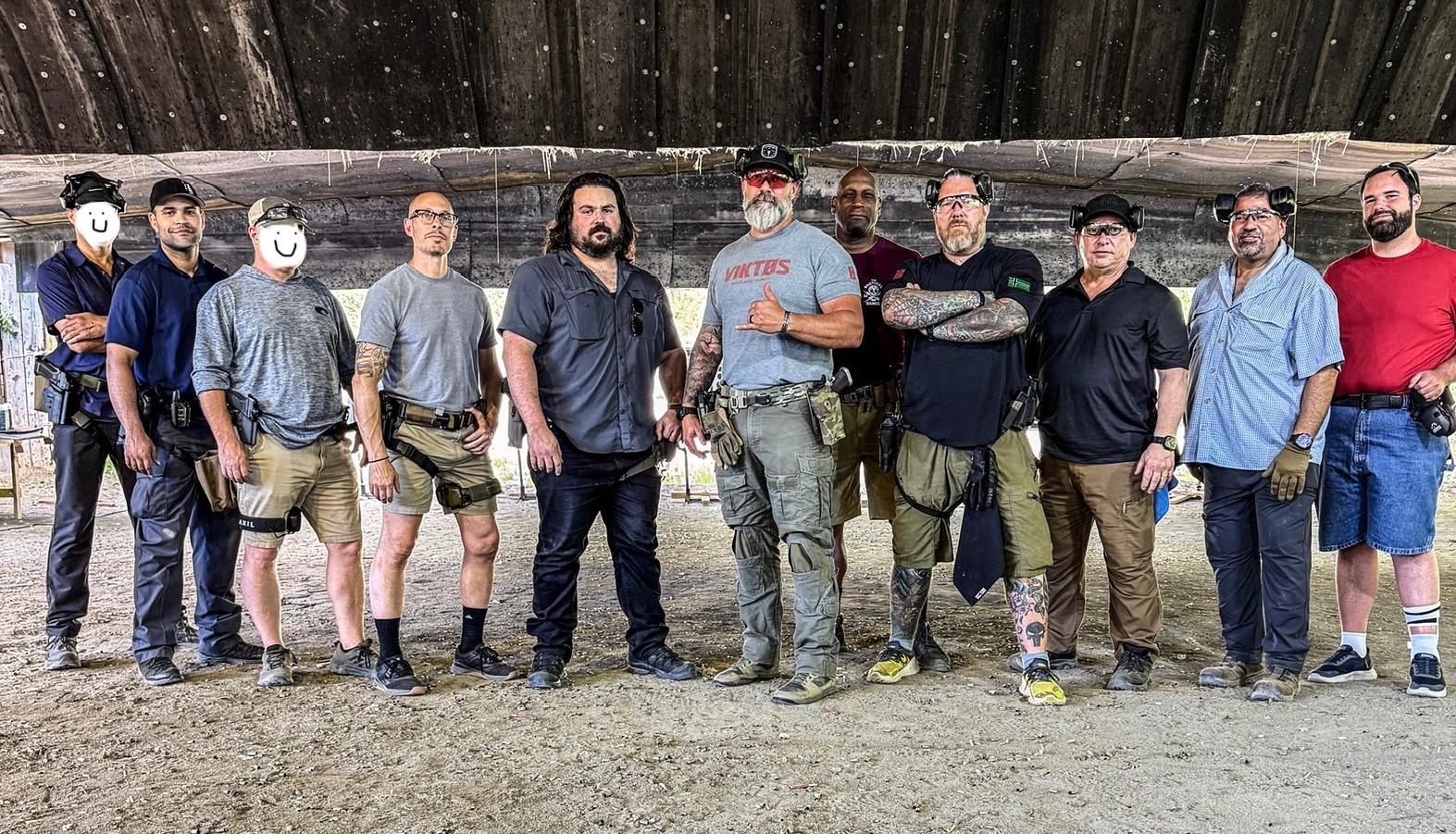
Author: Frank Woods
It’s been a while, and I apologize for my absence. Late last year and carrying forward into the beginning of this year (and in some respects still continuing to this day), I was faced with a set of circumstances that had an extremely demotivating effect on me. I didn’t want to shoot, I didn’t want to write, I didn’t have the drive to participate. I was lost and left alone in the dark. But I have since seen a light and started to find my way back to what I love and those I share it with; they never abandoned me, and for that I have extreme gratitude.
It had been over a year since I did any considerable amount of shooting in quantity outside of zeroing a few rifles and one pistol; nothing that measured or tested my skill set or performance. My solution was to dive head first into the subject matter and immerse myself in an environment full of those practicing the craft, in the form of a pistol class; my logic was that perhaps surrounding myself with people just as passionate as I was to the point of attending a course taught by a renown instructor would spark a memory, or a feeling, or something that reminded me why I do what I do with TASKER. It worked.
Today I’m going to talk about my experience in the Two Day Performance Pistol class taught by Jared Reston, my first class with him and to whom I therefore attribute the restoration of my drive and focus. Much of the material was familiar, but that’s not to suggest it was boring or dull; more like it had that “first time riding a bike after a while” feeling in that it reminded me of a lot of techniques that go into pistol shooting performance, and helped me get better with a few of them along the way.
About Jared:
I suspect that most people who read this are familiar with Jared Reston, who he is and where he’s from, but for those new to the game, a brief bit of background from his own web page: Jared retired from the Jacksonville Sheriff’s Office after 20 years of service. 17 of those years were on their Full-Time SWAT team. Jared was also assigned as a Detective in the Department of Homeland Security/Gang Investigations Unit, and he was the assistant team leader and lead firearms instructor for the SWAT team. Jared has been involved in the successful resolution of over one thousand S.W.A.T. missions, including several lethal force incidents. In retirement, Jared works for Safariland and Ridgeline Defense.
As of this writing, to my best recollection it was the first time I was taking such a class from an instructor of such caliber who was also from the same professional background as me; it wasn’t so much that Jared was easier to relate to (we’ve known each other for a while anyway), but it felt reassuring to know what mindset and frame of reference the POI was developed from; that I could apply all of it in the professional context, without also having to concern myself with whether or not the lesson plan was formed in consideration of this. Of course, the relatable sense of humor shared among cops was also welcome.
The class took place at the Dutchess County Pistol Association range up in Wappingers Falls, NY. It was my second time shooting there, as this is where Ben DeWalt from Onsight Firearms Training regularly hosts instructors when they’re in the area; he’s got a whole circuit up and down the east coast that he routinely runs to host guys like Jared. Ben and his wife Rachel also provide their own classes with their own vetted POI; they are among if not the best New York has to offer the greater training industry, and they make the effort to remain considered in such high esteem consistently in everything they do.
If it weren’t for Ben, the Northeastern US would be deprived of high quality instruction on a regular basis. He is keenly aware of this and takes pride in the quality of his service. If you’re in the area and want to make better use of your range time in terms of refining and improving your skills as a marksman, Onsight is my first recommendation for you to check out; whether they’re hosting a premiere instructor or offering their own classes, you can’t go wrong.
I made the two hour drive North for two reasons: First of all, I hadn’t been to a class since April of the previous year, having had to skip/cancel my plans to attend a Mark Smith class earlier this year in May. Second, when the gang’s in the back yard and I’m off work the days of the class, I really have no excuse to not attend and throw them some business; it’s never a waste of gas, time, or ammo.
Since I was driving, pulling gear was easy. I grabbed my gun belt, my two AXI blasters (I hadn’t decided which one I wanted to use yet), a case of corroded ammo (more on that later), an overnight bag with a change of clothes and whatever other stuff I needed, tossed it all in the trunk of my car and hit the road. When I got to my hotel I got to sleep to make sure I had plenty of rest for an early start the next morning.
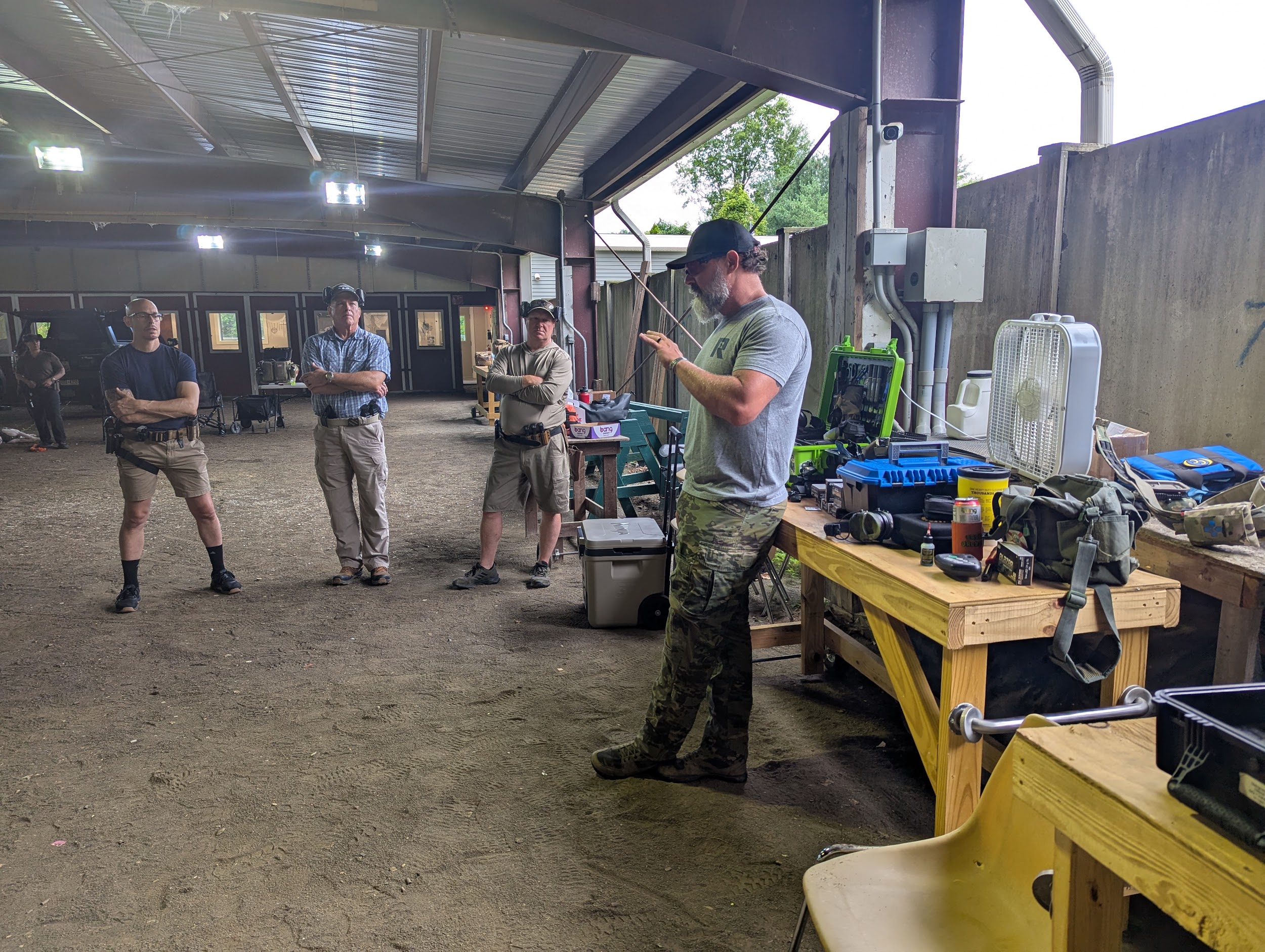
TD1 started pretty simple. Jared said we’d be working on skills, not drills, and that he liked to approach that by starting with fundamentals. His reasoning was pretty straightforward: You shouldn’t shoot fast until you can shoot slow, and then you build speed via efficiency.
For those in the audience wondering, that is what “slow is smooth, smooth is fast” means. If I had a nickel for the amount of times I’ve seen men who ought to understand this lose their minds and start bitching and moaning about how “SLOW isn’t FAST,” completely overlooking the linear logic of the process described, I’d be out of debt. So it was refreshing to hear Jared employ that perspective, even if he took the scenic route with his choice of words.
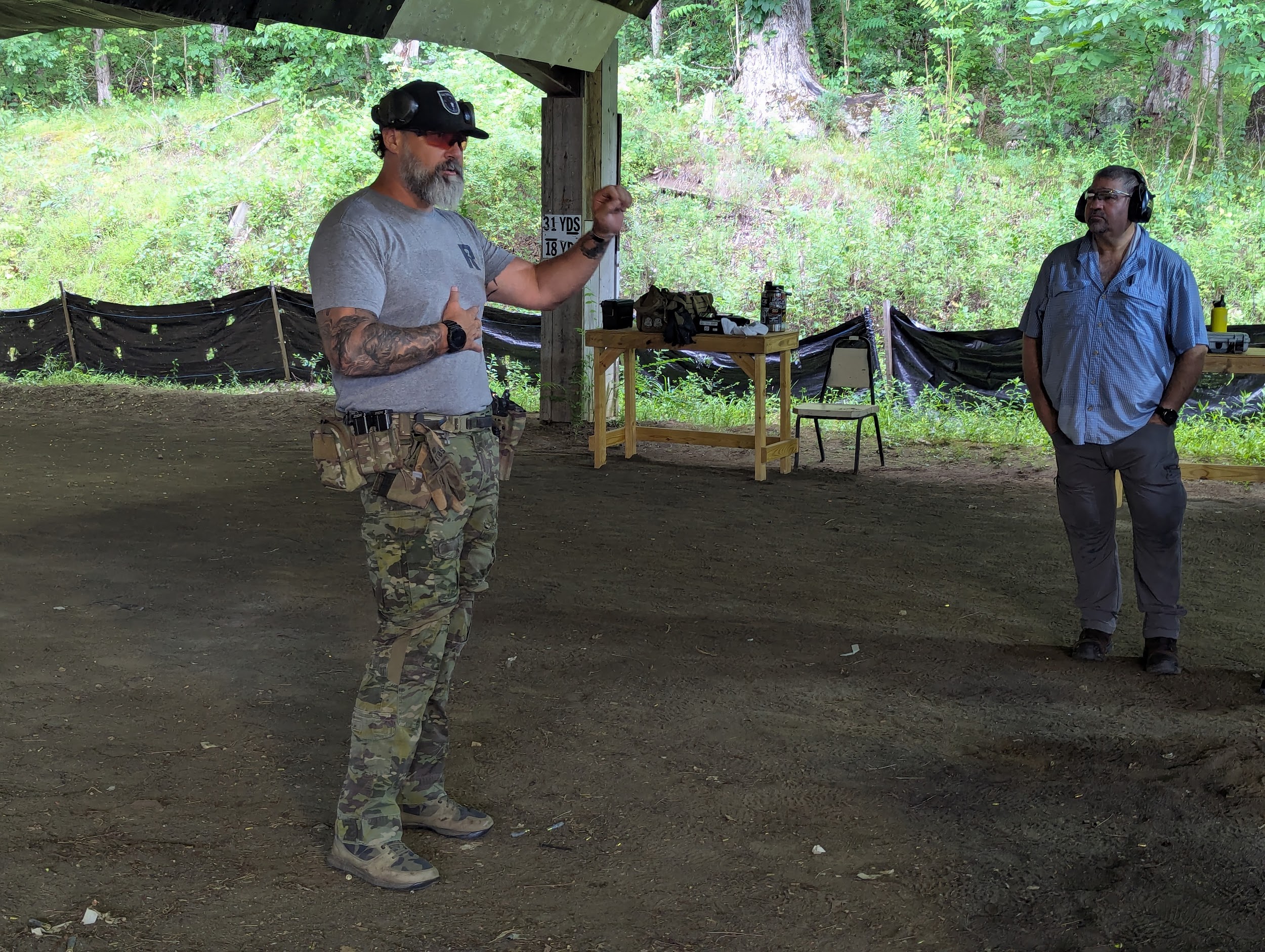
He explained further that while his pistol course isn’t “for bullseye shooting,” but for practical shooting using bulls, or B-8s. B-8s are easy to score; Jared compared it to lifting in the gym and knowing how heavy the weights you lifted are because it says so right on them. That added up, so I accepted it without second thought, even though I’d never questioned the use of B-8s before. I’ve heard some knock them in favor of standard IPSC targets tracking A and C zone hits, but it made me wonder if they were deflecting because they found the smaller target area of the B-8 more challenging. I have and do shoot both so I’ve never been one to get all format war over it.
So in approaching the course of fire from the fundamental perspective, each string of fire starting out focused on building out a different part of one’s shooting stance: foot placement, grip, trigger pull, sight picture, etc. This really helped me figure out aspects of stance I hadn’t been taught, and things about grip I had been having trouble figuring out previously. Jared has a way of relating the information to the students that makes it easier to visualize and internalize; There were a couple of lightbulb moments for me where once it clicked, I was able to use and see the effect of this new information on demand, repeatably so.
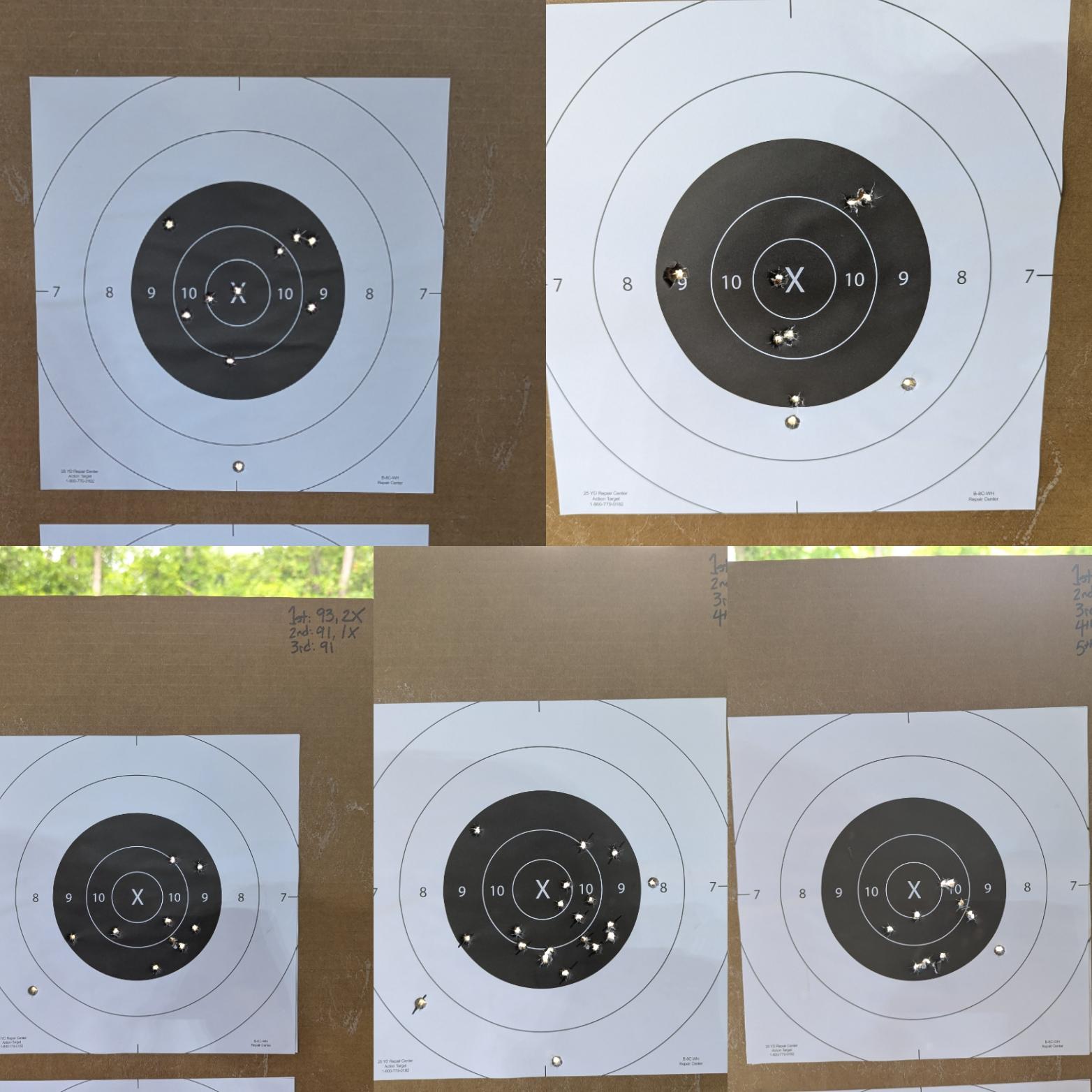
We fired eight strings on B-8s before switching to the Jared target. All targets were shot freestyle (two hands on the gun). All of my B-8s were scored in the 90s with at least one X hit, save for one. My first two targets were a 93/2X and a 91/1X. Nothing to brag about, but considering how long it’d been since I’d shot pistol for performance, I didn’t hate it. It was between my third (91/0X) and fifth (94/2X) targets that I started noticing my group was printing with a discernable low right trend on the B-8. After the fifth string I looked at the target, then looked over at Ben and Jared, and started to ask, “Would you adjust?” Both of them answered me before I could finish the question: “Yes, definitely. Come up 2 clicks and move left 2 clicks.”
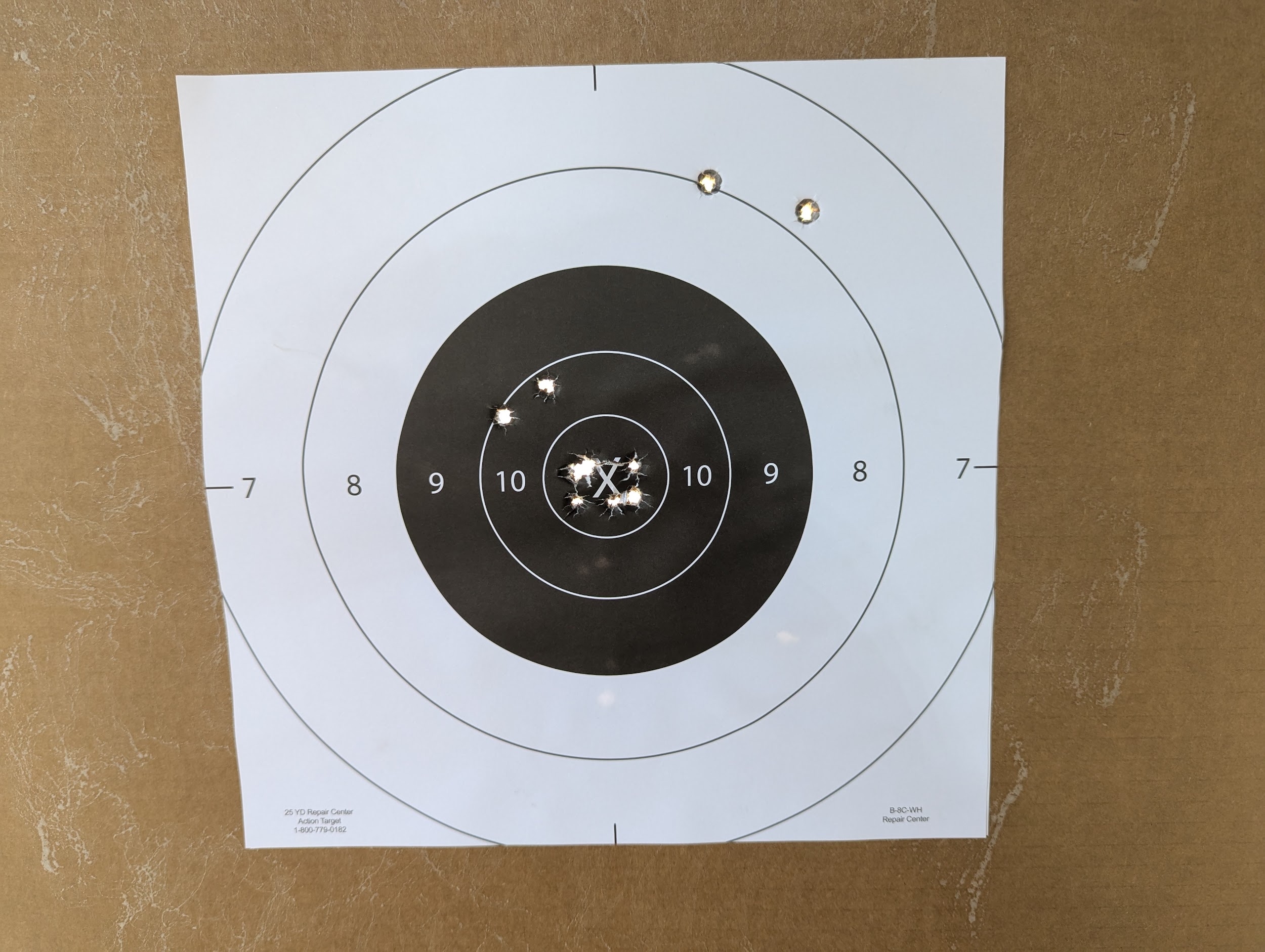
I dialed in the corrections and went back to the firing line. I don’t remember which fundamental we were working on, but my next target was probably the best B-8 I’d ever shot in my life: 95/6X. If my previous targets weren’t enough to convince me, this one certainly did: Not only had I retained much more of my skill set than I had given myself credit for, but it was less a matter of feeling like “I’m back” and more a matter of it being like I never left in the first place.
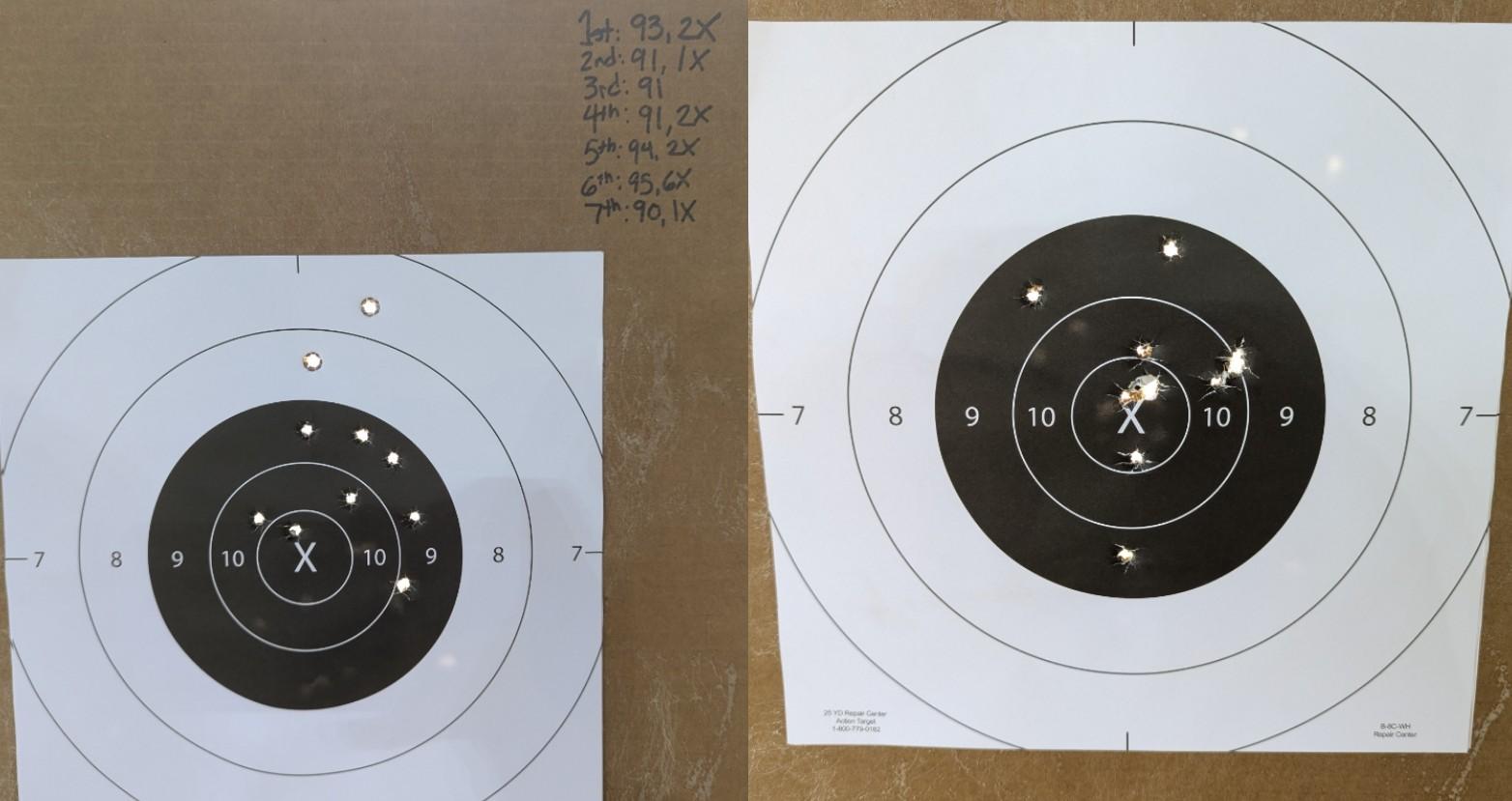
My next target saw a drop in quality, clocking in at 90/1X, but I even wrote in my notes right after that string that I was distracted due to external matters elsewhere, and between my mind wandering and my glasses being dirty it took its toll on my performance. I cleared my head, cleaned off my glasses, and got back into focus. Jared walked us through his pre-shoot “ritual” or practice preparation routine, and we shot again. My eighth and final B-8 on TD1 was a 97/4X. I was quite pleased with this; it wasn’t perfect, and although higher in score it wasn’t as pretty as my 95/6X, but I wasn’t complaining. Part of me felt like, “I didn’t know I had it in me,” at the same time however I don’t know what it was that Jared said that clicked and got me there, but knowing I was so capable certainly instilled confidence.
Before I continue talking about the class in terms of what Jared had to offer, I want to take a moment to point something out. There was a point during the class where I assessed my target against all the others on the firing line. Excluding the target Jared was using for demonstrations of the drill, I saw only one target that looked like mine; the groups on paper were commendable, and the B-8 scores were neck and neck in comparison. Not to suggest everyone else in the class were amateurs, but it became very clear that at least two of us had some experience and knew what we were doing.
“Who’s giving me a run for my money on this firing line?” I wondered. It turned out to be Ben’s target, which he confirmed after I asked if he was target number seven. “Of course it is,” I thought to myself. I asked him what he was shooting with, and he said “Glock 17,” which I could tell only had some minor modifications when I looked at it. That made me realize something, so I asked Ben to send me a picture of it and a list of the modifications he’d made to it.
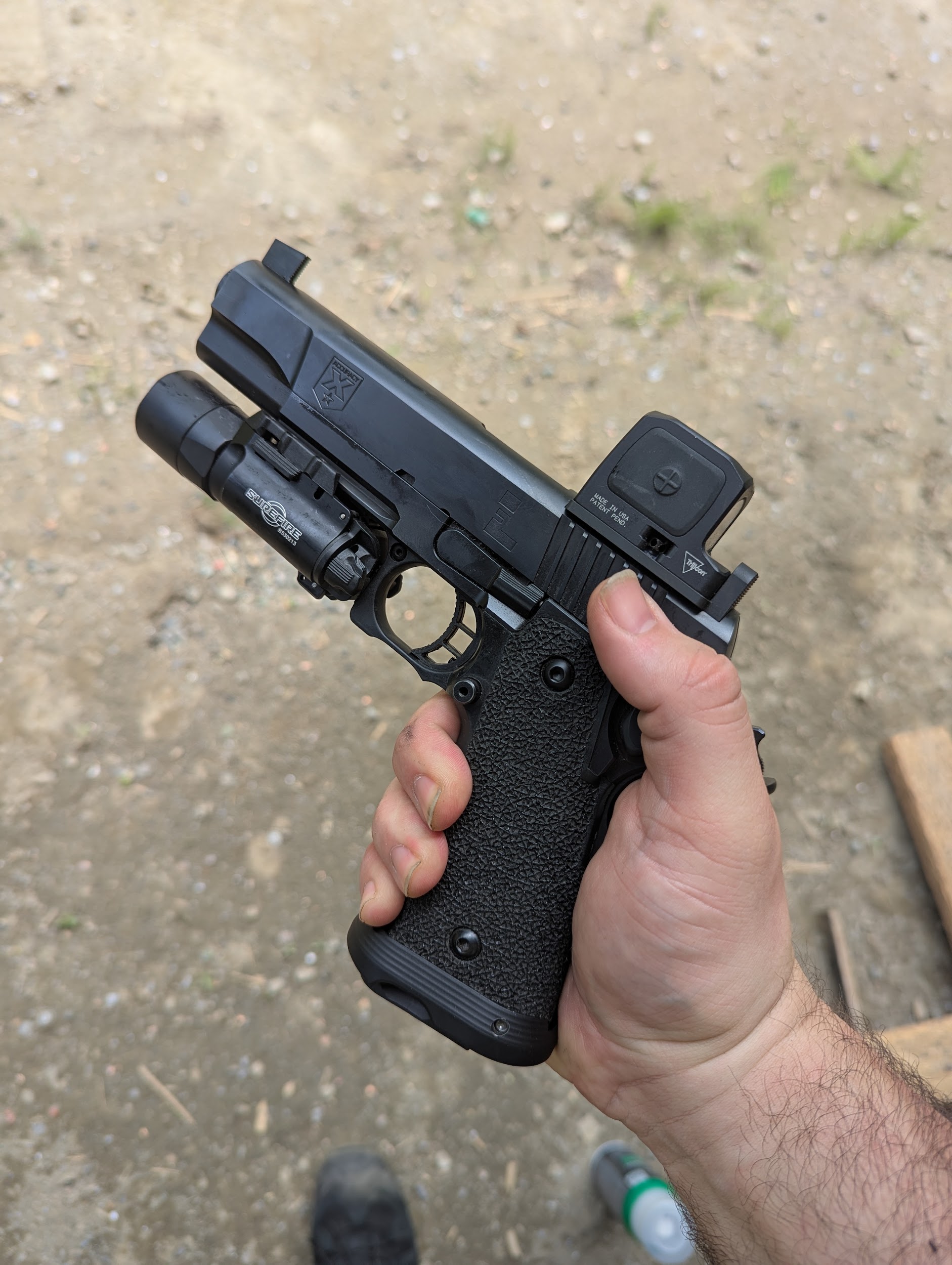
I was using the Gunfighter; you’ve all seen and heard of that one already, and I ended up using it because it’s the easier one to shoot more precisely than the Darkfighter since the mag well helps me lock in my grip. Ben’s Glock 17 is pictured below:
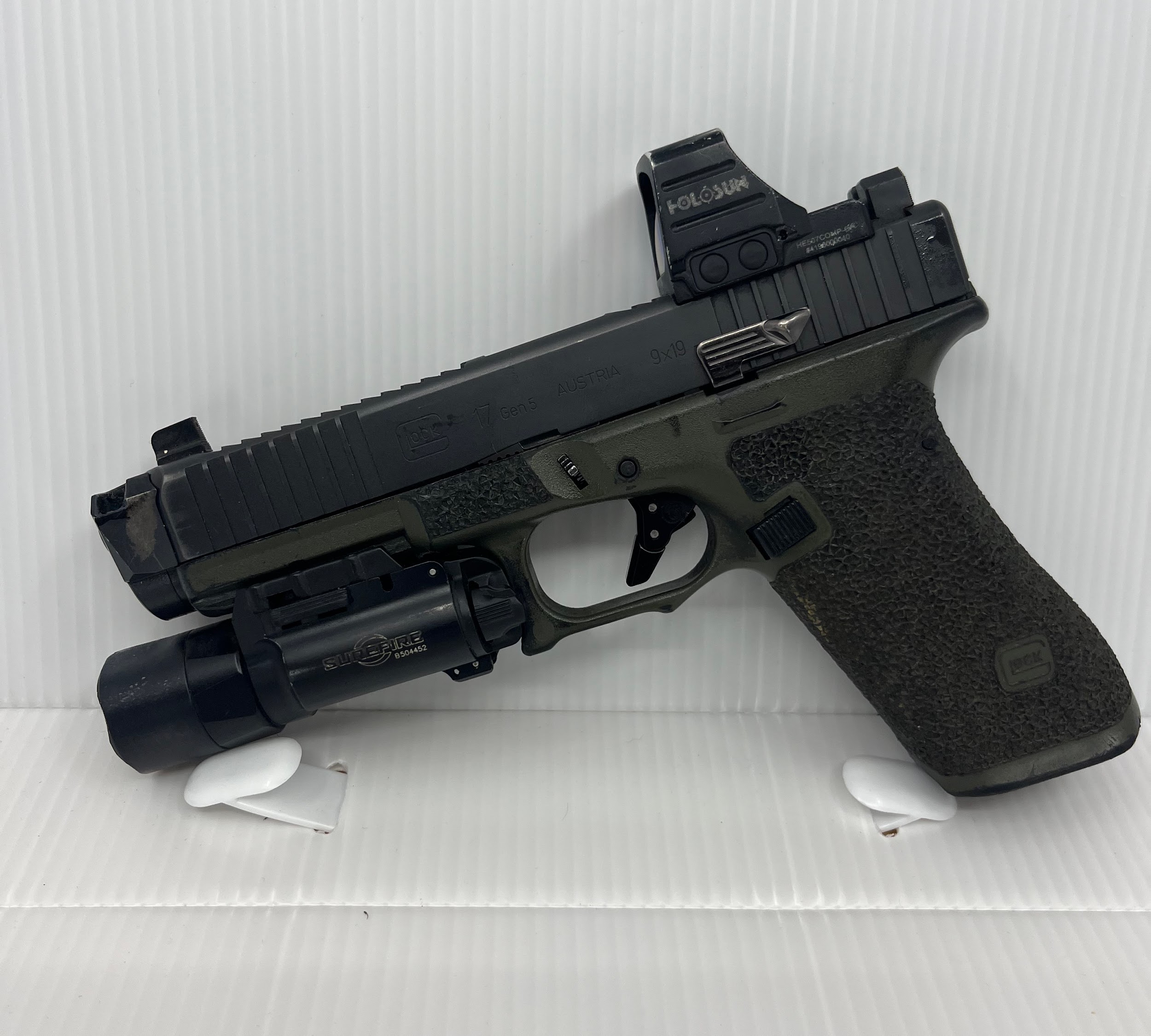
His modifications consisted of:
• Slide cuts and optic mount by ATEI
• Night Fision ⅓ co-witness stealth night sights
• Radian Ramjet and Afterburner barrel and compensator
• Grip stippling and reduction by Great Lakes Custom Gun Works
• Timney Competition 3lbs trigger
• Kagwerks Slide Release.
Nothing crazy, right? I averaged our B-8 scores at the end of TD1, not including X ring hits since Ben wasn’t recording his. My score averaged out to 92.75, and Ben’s score average was 92.625. At the end of TD2, we both tied at 92.75. Upon coming to this conclusion in the data comparison, there were two old sayings that came to mind: “It’s the Indian, not the arrow,” and “The clothes don’t make the man.”
I had a tightly toleranced precision machined 2011, Ben had a Glock 17 and its comparably sloppier tolerances with some drop in parts and grip work. In either case, Ben and I were using two very different pistols and achieving the same results; alternatively, nobody can say “You were only doing so good because you had a fancy pistol.” Bullshit. I already said, I hadn’t shot for over a year; Ben shoots all the time. How was that possible? The answer is simple.
I overheard Ben coaching someone else on the firing line, saying that they need to get to the range to practice more often, and I pointed out the similarity in our performance despite the fact that it had been so long for me. He responded by pointing out said shooter hadn’t put nearly as much work in compared to me up to this point (once every few months and as a newer shooter), so I could afford to take some time off before getting back on the horse and still ride at full stride; Shooting is said to be a perishable skill, and that day I realized that the speed at which it perishes is relative to the time you’ve invested in training and practice before you stop for a while: it goes slowly if you do it often enough up front.
The moral of the story: “You’re only as good as you are that day, not the last day you were in class.” If your marksmanship capability is on point and you’ve put in the effort to develop that skill properly, it doesn’t matter what gun you’re shooting with; you will deliver. That doesn’t mean you should slack off and get lazy with your practice; don’t use me as an example, I was the exception. I consider myself lucky to have retained my skill as much as I had despite such a long absence from the range. I should have been going more often. Go as often as you can and if you’re so busy that you can’t go once a week or even once a month, make each round count when you can go and stay on top of your dry fire in the meantime.
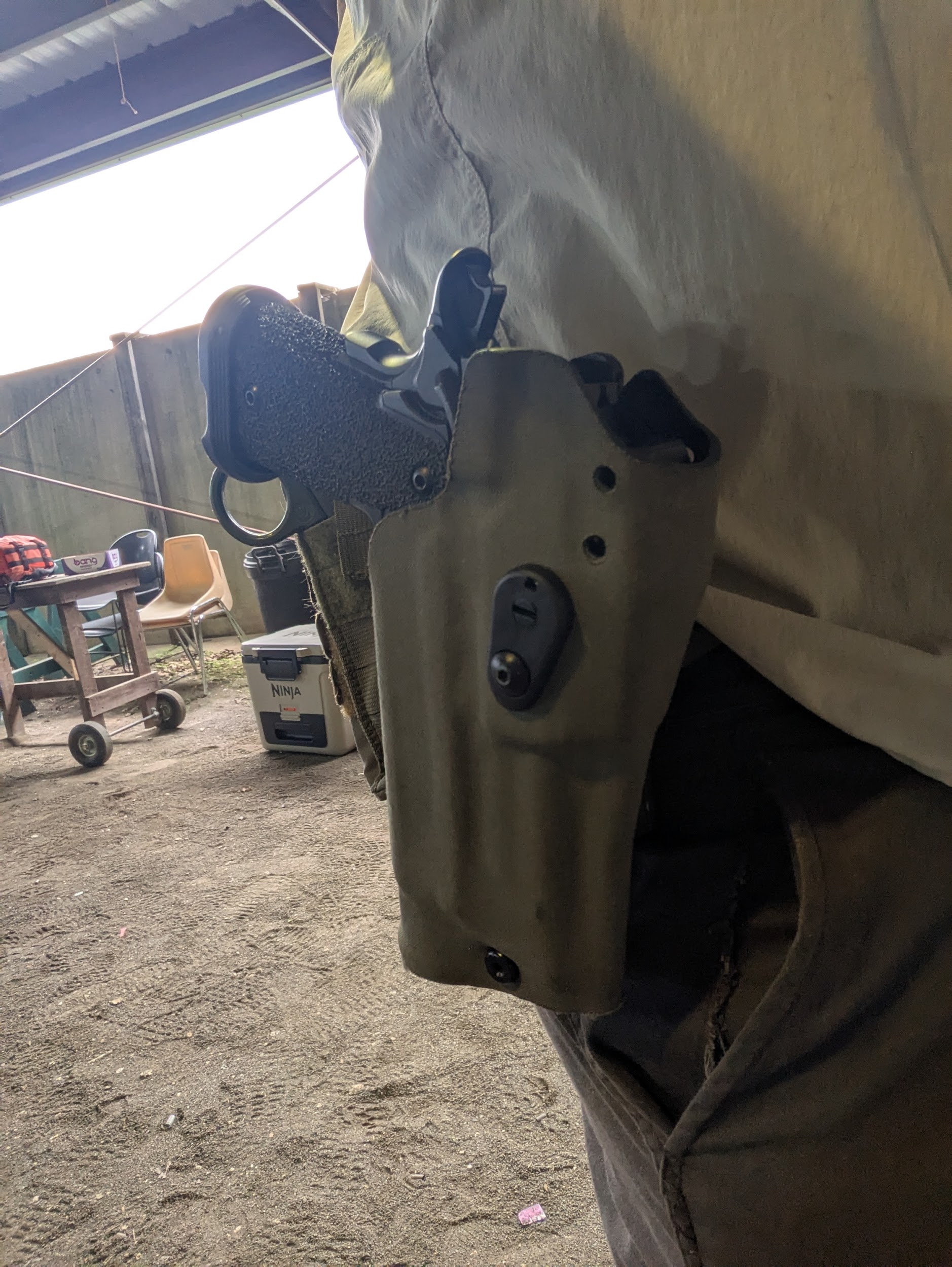
Once we got off the B-8 targets, we started working from the holster with the draw built into timed drills. Jared does a good job of breaking one movement down into multiple parts to lock in on and make sure you’re doing everything right; it’s one thing to know what right looks like, but things really start to click when you know what right feels like. Then it all just flows when you’re doing everything fast.
Parts of the draw process that stood out to me that I need to work on are grip and presentation on the draw from the holster under speed as it relates to seeing the dot and not having to correct too much once the gun’s out there. That’s easy to do from home with dry fire, it’s just a matter of pulling my gear from my locker and actually doing it. The other thing I had trouble with was trigger prep, but I hesitate to use the word “trouble” since I understand the concept and the mechanics of trigger prep; it’s the pistol I was using in this case that seemed to not want to cooperate.
So, there are two parts to this. The first is mechanical: basically, it’s how far you can pull the trigger without the gun going off, thus “prepping” the trigger. With a striker fired gun this is easy, I’ve done it with a Glock a ton of times. Once you hit “the wall,” the remainder of creep in the trigger between the wall and ignition is your “zone” for trigger prep; 15 years with a 12 lbs trigger really helps you get a feel for it. But with a 1911 style trigger like all 2011s have– at least in my experience– trigger prep is harder to get a feel for. I could be wrong, but to me, on my 2011 there’s the slack in the trigger, the wall, and then the hammer drops.
I’d go as far as saying trigger prep on a 1911 isn’t so much about how much creep in the trigger you can get away with that you need to get a feel for, but rather how much pressure you’re applying to pull the trigger that you can get away with. You can ride on the wall without the gun going off on a 1911 style gun (provided you don’t have a stupid lightweight or nasty grainy trigger), but you still gotta apply pressure with your trigger finger at that point to trip the disconnector to kick off the firing cycle.
Aside from the mechanical, there’s the mental/habitual aspect of trigger prep one has to overcome. I would wager that damn near every gun owner who’s received even minimal instruction on the operation of a firearm has been taught to keep their finger off the trigger, and indexed along the firearm outside of the trigger well entirely, until they have acquired a sight picture of an intentional target. Be it casual or professional use, this tenet of marksmanship and firearms safety is everywhere.
With trigger prep, you’re being asked to override that years-developed routine and reverse it: Here, you’re told to put your finger on the trigger and start pulling it before you’ve even finished fully presenting the gun and started acquiring a sight picture (with a red dot pistol, this is the moment when you see your dot superimposed over your intended point of impact). So it feels weird at first, even with the instructor telling you “As long as the gun is pointed safely downrange, if the gun goes off early and you don’t get your hits I won’t count it against you because here you’re training and learning the technique.” That goes in one ear and out the other when faced against habit and muscle memory (relax, you know what I mean). You have to force yourself to do it.
But before we even got to doing it in live fire with Jared, he had a really good way of showing us what to feel for that involved watching ourselves pull the trigger and how far back it would move before the gun went click. That takes us back to the mechanical matter I mentioned earlier. I’ll chalk this up to Jared being a more experienced shooter than me, but I gotta say, having done this with a Glock and knowing how it should go, I’m standing there looking at the Gunfighter’s trigger once I hit the wall… and that fuckin thing ain’t moving.
But Jared is watching me and going “Pull a little bit more. A little bit more. A little bit more.” I wasn’t seeing the trigger move, but I was feeling the pressure in the pull increase bit by bit until the hammer dropped. My biggest takeaway from this was to take the time to learn your gun and be mindful of that extra data point: How much you can pull your trigger before the gun goes off, and when during the shot process to take up that slack. There’s a time and a place, usually dictated by target distance.
From that point forward, I resolved to thinking “Hitting the wall on this trigger IS the limit of trigger prep that it permits, so I’m just going to ride the wall,” kind of like the opposite side of riding the reset. After trigger prep we started working on follow through, basically tracking your dot and restaging your trigger so that all of that was ready before the gun finished cycling.
We finished up TD1 by going over some firing cadence and reload drills. We also did some timed one shot draws from the holster; my average time was about 1.7 seconds.
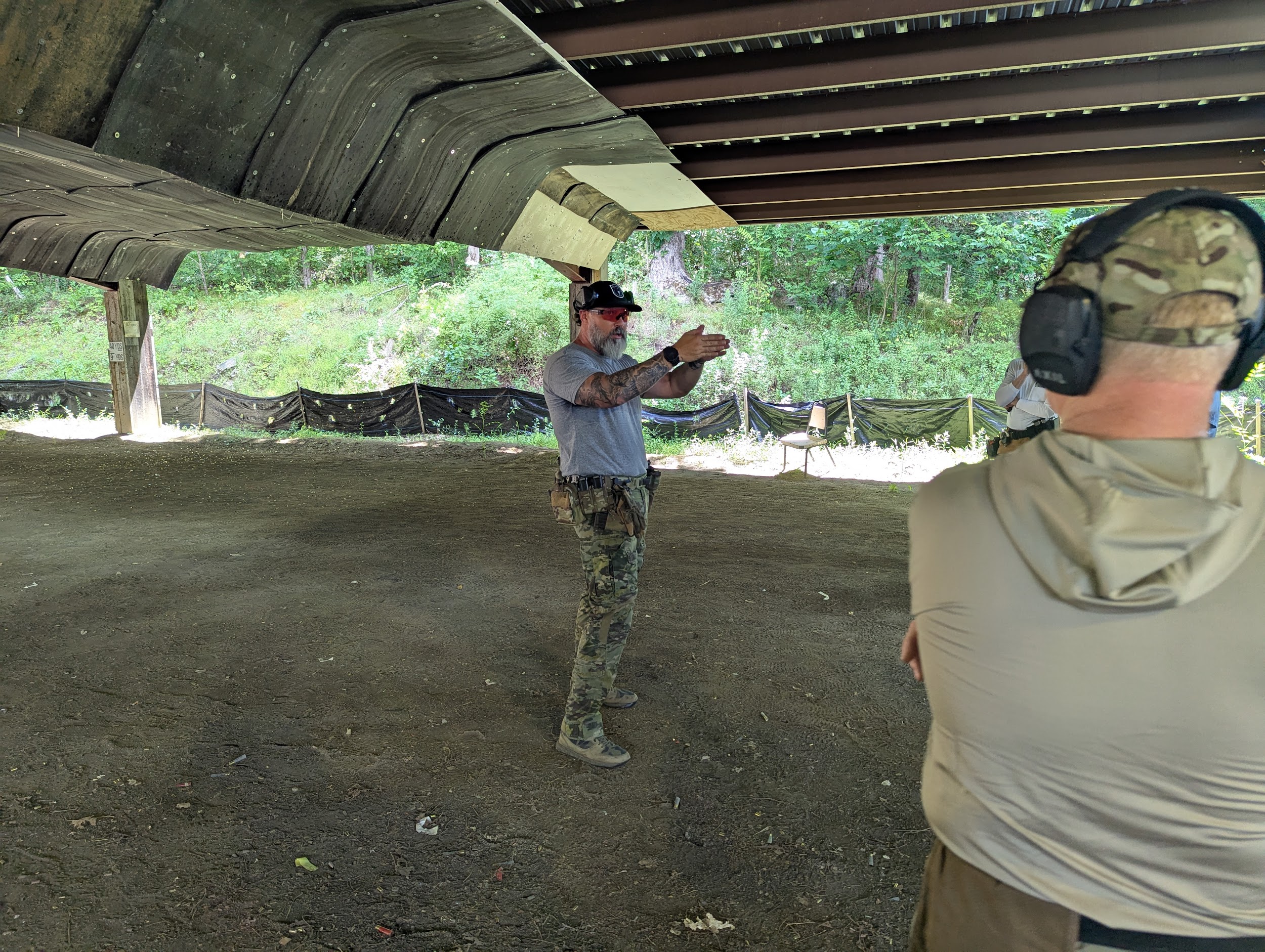
Something funny came up during TD1 whereby Jared was explaining a matter of mindset in the “Don’t overthink it” context. I don’t precisely remember what he was addressing, but at one point he said “The storm doesnt care about wind and lightning and rain, it just is. You gotta think about it like, “I am the storm.” This reminded me of the Alpha Chair, so I made a point to share it with him after class and suggested he change his script to saying “I am the Chair,” something I think to myself after seeing that video whenever I feel like I’m being tried or tested by circumstances beyond my control. When it came up the next day and he reiterated “I am the Storm,” we immediately exchanged looks and smirked, and he said “I am the Chair.” Damn right.
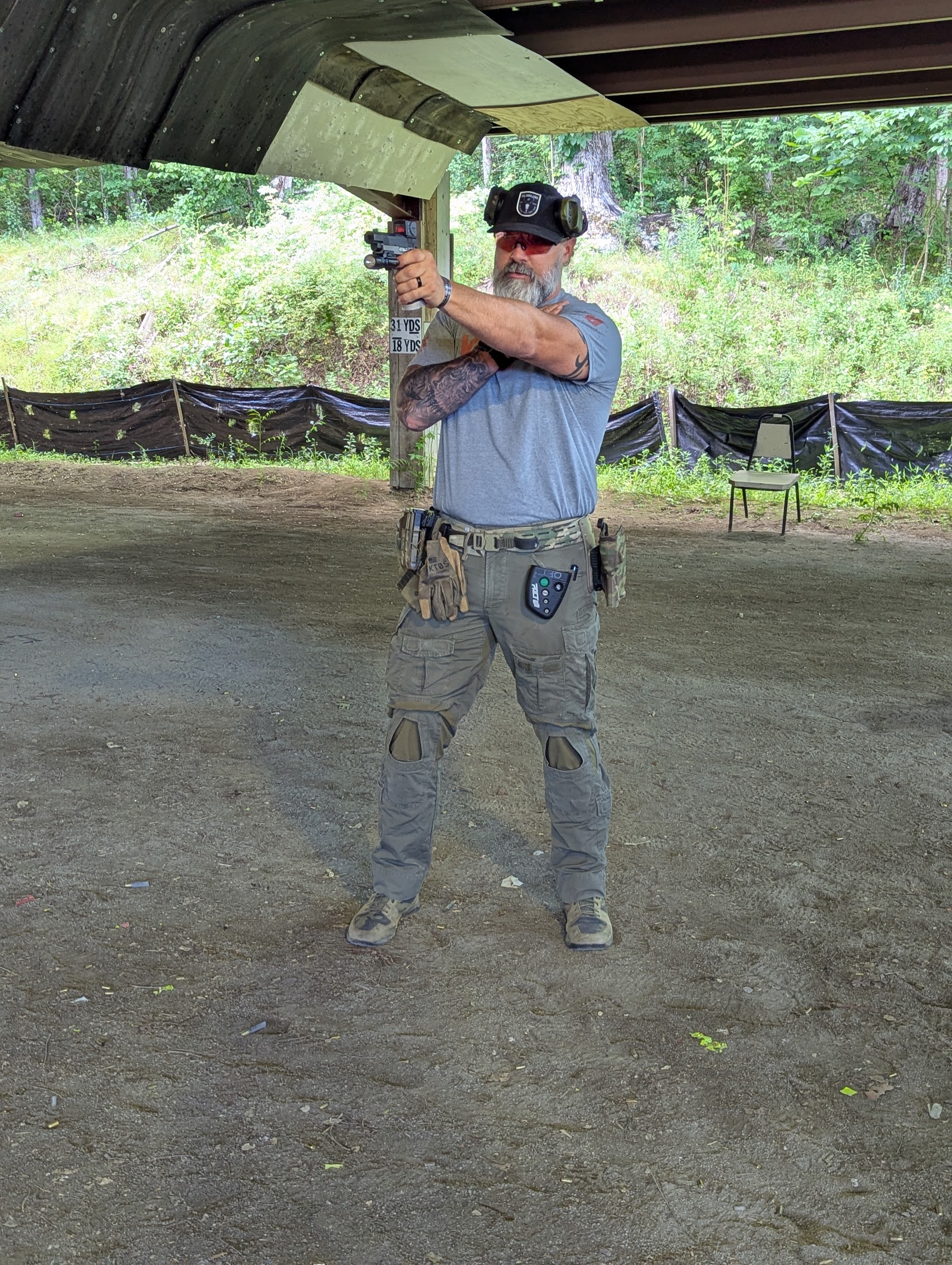
We started up TD2 by shooting more B-8 targets, all of them from 25 yards. The first string was for as long as we needed to fire ten rounds, but it didn’t take that long. Then we included the draw from the holster into the drills from there, and timed it; 10 rounds in 5 seconds, and 5 rounds in 10 seconds. Based on what he was seeing on the targets by the majority of other shooters, Jared made us shoot one string of fire Strong Hand Only to illustrate throttle control against pulling the trigger when you think you want to versus when you know you’re lined up and ready to do so. I was expecting lackluster performance here, again because it had been so long since I’d done any SHO shooting, and for the fact that my pistol is a laser gun and would betray my errors; if I missed, it was on me. I ended up shooting a 96/1X for that drill. To say the least, I was impressed. “Still got it,” I told myself. We went back to shooting freestyle for the remainder of the class.
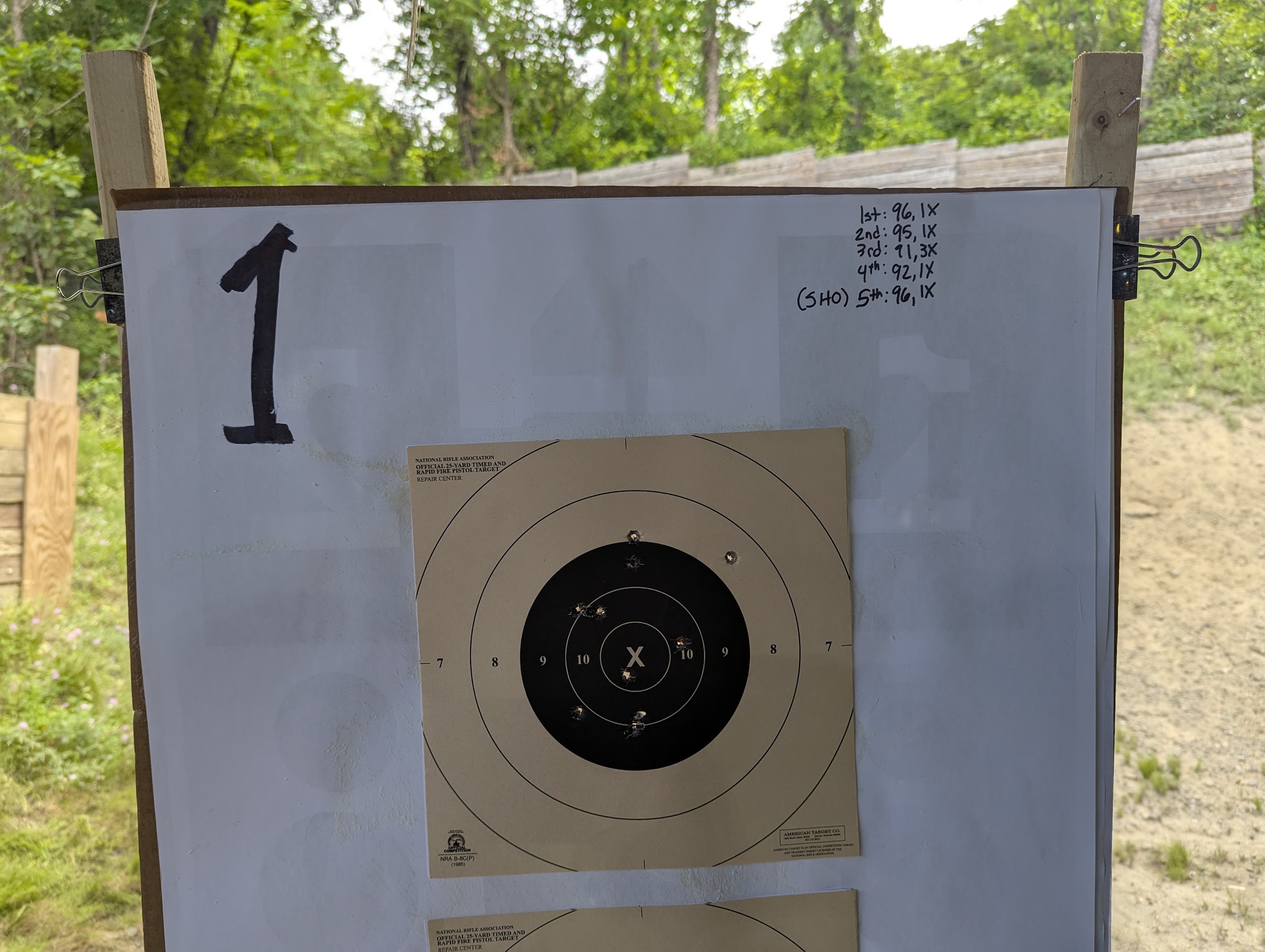
All of my B-8 scores on TD2 were in the 90s, except for one (an 82/1X): On the last string of fire utilizing a B-8, which was a timed drill, I failed to get my tenth shot off in time because I was clearing a malfunction. This was not the fault of the gun; it was squarely my fault for being lazy. Several months beforehand, sometime during 2024, I plussed up on ammo and ordered a few cases of the usual suspects: 5.56, .308, and 9mm. When the shipment arrived I was exhausted and didn’t feel like lifting and hauling a bunch of cases of ammo into the house, primarily cause I wasn’t sure where to put it without it being in the way… So I left it there.
It got rained on, and dried, and rained on again, over and over until within an hour before leaving for this class with Jared, I cut the boxes open to find the case of 9mm to throw in my trunk. It had rained heavy a few days prior, and everything was still wet; the rainwater had soaked through the outer boxes and got down to the individual boxes of ammo themselves, to the point that I could pretty much peel the boxes apart with little effort to get to the trays of ammo inside whenever I was reloading mags during the class. At that point, each individual socket that the cartridges are kept in still had rainwater in them.
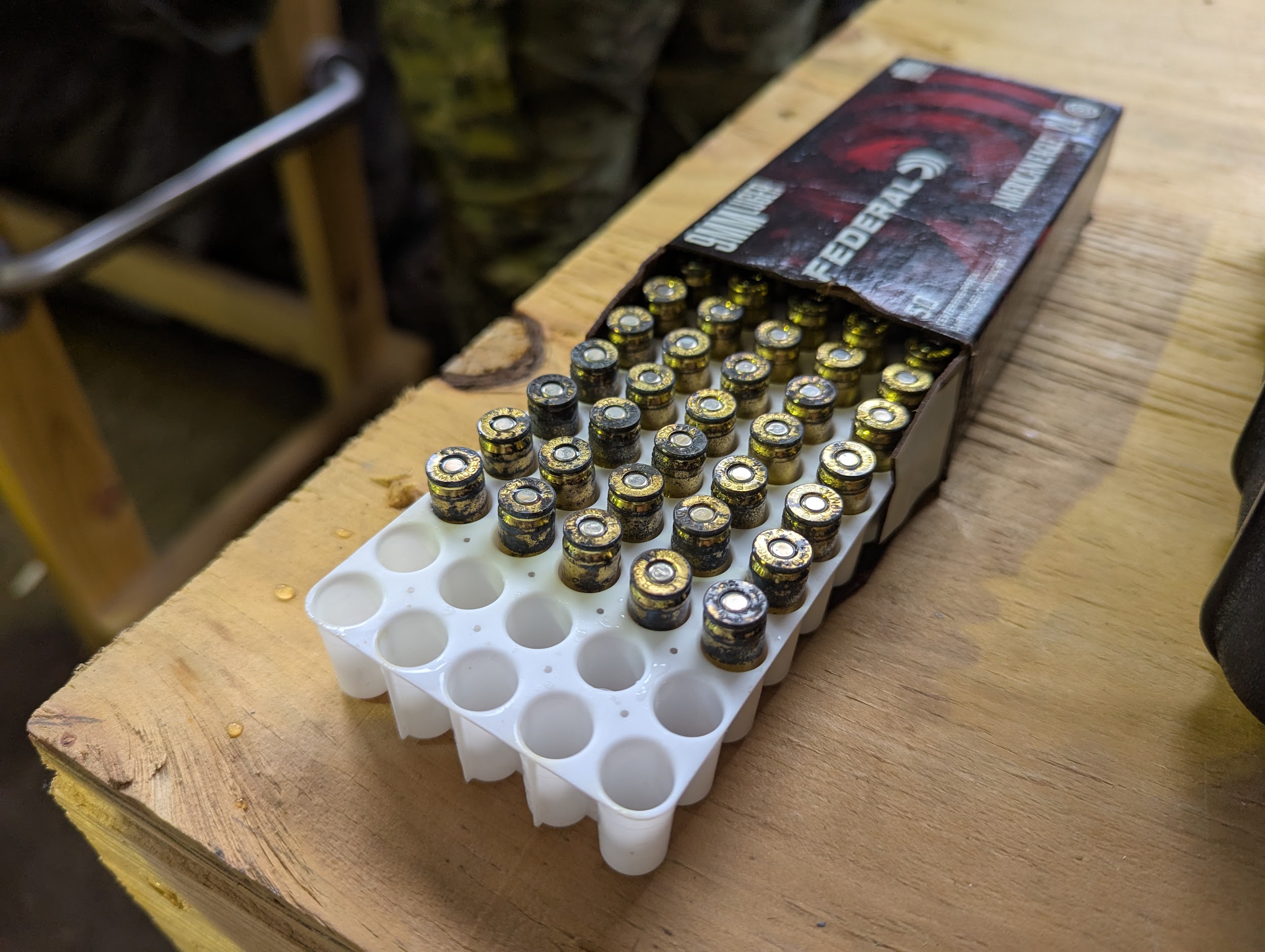
The result of my neglect was that the ammo had become corroded on the exterior of the shell casings and projectiles; rather than the typical copper and brass coloring of FMJ rounds, almost every round had blue gray smudges on them, going down about half the length of the shell casing. There were one or two times other classmates saw my brass on the floor or the ammo as I was reloading my mags and walked up to ask what kind of ammo I was using. “The same shit you’re using most likely, it just sat out in the rain for a bit.”
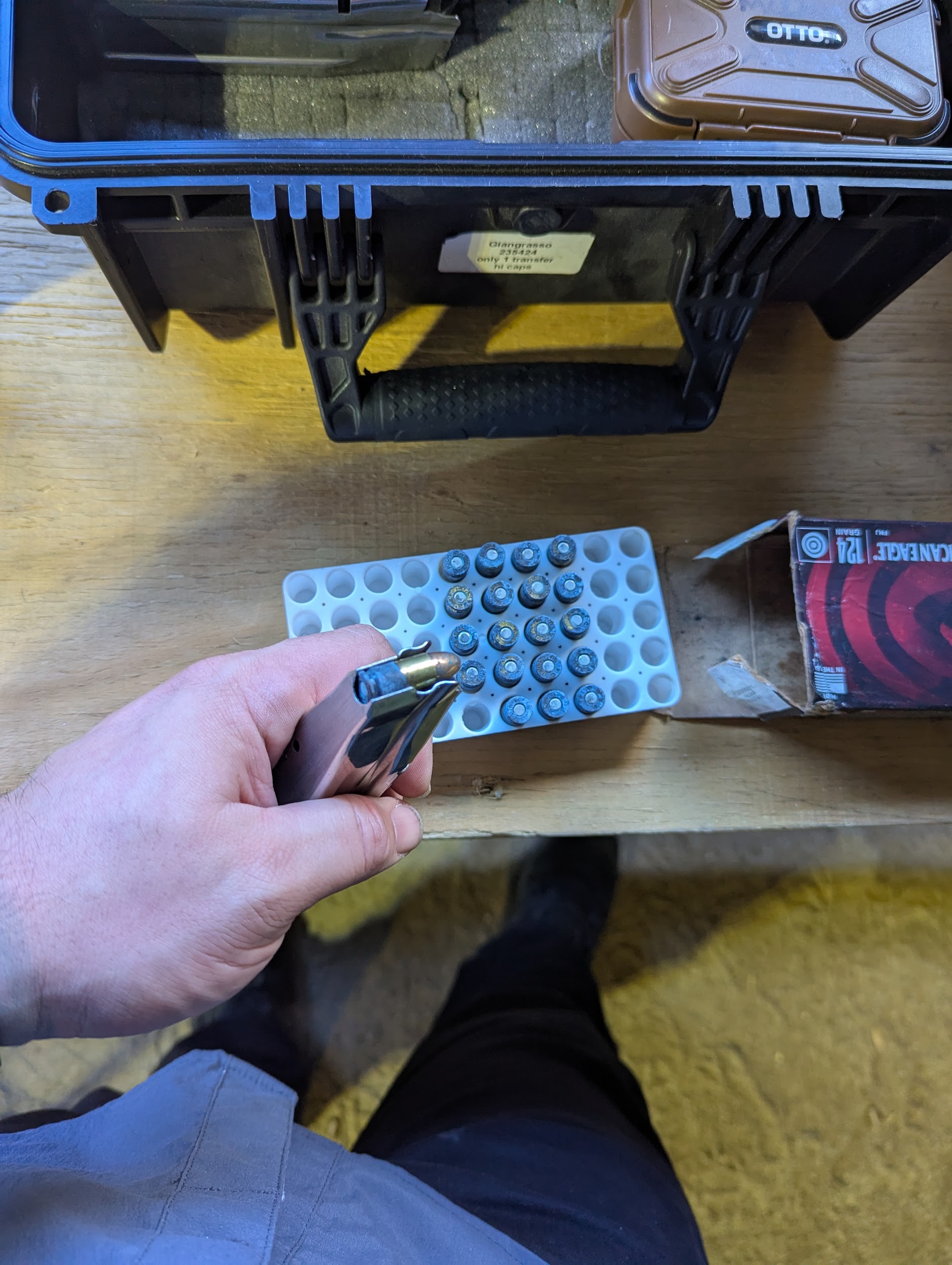
So, for the discerning prepper that’s wondering how reliable ammo can be after longtime exposure to the elements… Out of ~500 rounds fired over the course of two days, I believe less than five were duds that exhibited the same behavior as light primer strikes. Simple tap, rack, bang for those. When I saw the unfired round come out of the gun, I’d retrieve it later for inspection and find the dimple in the primer indicating it failed to go off. Whether that means it was a quality issue or if water got into the shell casing and the powder was damp/wouldn’t ignite, I don’t know because I didn’t pull the rounds open to check inside. I only attempted to recycle one of these rounds and it didn’t go off the second time either.
The more common problem I had was failure to eject. I attribute this to some casings having so much corrosion buildup that they wouldn’t slide out of the chamber once pulled by the extractor. But it didn’t result in a double feed, it was weird. I would fire the gun, go to fire again, and once I got the click I would tap/rack only to see an empty shell casing fly out of the chamber. This was really annoying when we were doing timed drills of 5-10 shots and mid string I would malf and clear it and continue at the detriment of either lost time or a dropped round, depending on how many rounds were left in the mag when it happened relative to the course of fire.
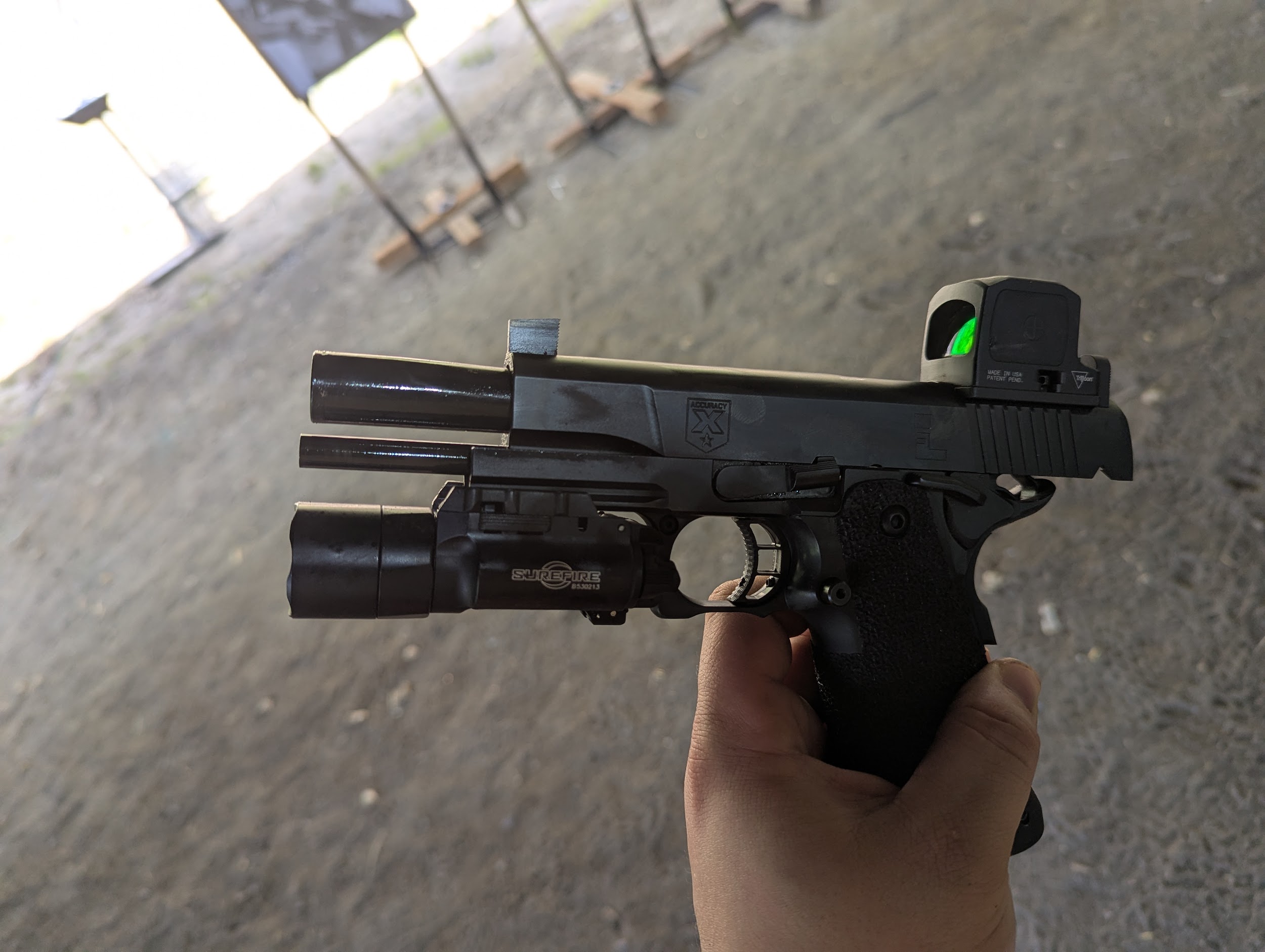
The only other issues I had were occasional stovepipes, which I chose to interpret as a fumbled ejection due to the corrosion whereby the casing was too slow to fully eject by the time the slide started to close on its return cycle. I would simply knock those out of the way and keep going once cleared. An inspection of my extractor revealed that it was intact and undamaged, so I know it wasn’t a failure of that particular component. Aside from oiling the gun (which never really went dry in that respect) I tried applying a drop of oil to the top side of each cartridge as I loaded them into the magazine to give them some more lubricity but that didn’t really seem to solve anything.
…all of this to say: Will the ammo work? Yeah, most likely. But you might have cycling issues. At one point Ben’s wife Rachel cautioned me to watch out for a hangfire, but thankfully that never happened. What really pissed me off was knowing I had whole cases of training and defensive grade 5.56 and .308 sitting at home from the same shipment probably in the same condition, which would need to be further evaluated before using for training or defensive purposes. Hopefully they aren’t in as bad of shape. Most of these ammo related problems occurred on TD2; on TD1 when they did occur they were spaced far enough apart that I didn’t think it’d be as much of an issue. Thankfully it was minor, but a teachable moment in not being lazy and thinking “It’s not steel ammo so it’s not like it’s gonna rust.” It’s a stupid problem to have, as I like to say.
There was a bonus lesson, or reminder, in economy of motion. At one point on TD1, the wind kicked up in such a way that some of the targets got blown over, which was further prevented by weighing down the base of each target stand with a rail tie. But when I approached the targets to help pick them up (they’d fallen forward), something clicked: I was going to use two hands either way; I could put them on both of the furring strips that were holding up a single target, or I could stand between two targets and grab the right of one with my left hand and left of the other with my right hand and pick up both in the same movement I would have to do for the single target anyway. I got a twofer out of it instead of having to make an extra trip. Points for efficiency.
This was long for a class “AAR,” but it’s been the first course in a while and it gave me a lot to think about. The plan worked: I knocked the dust off expecting to find rust beneath it, only to discover there wasn’t as much dust as I thought there’d be in the first place.
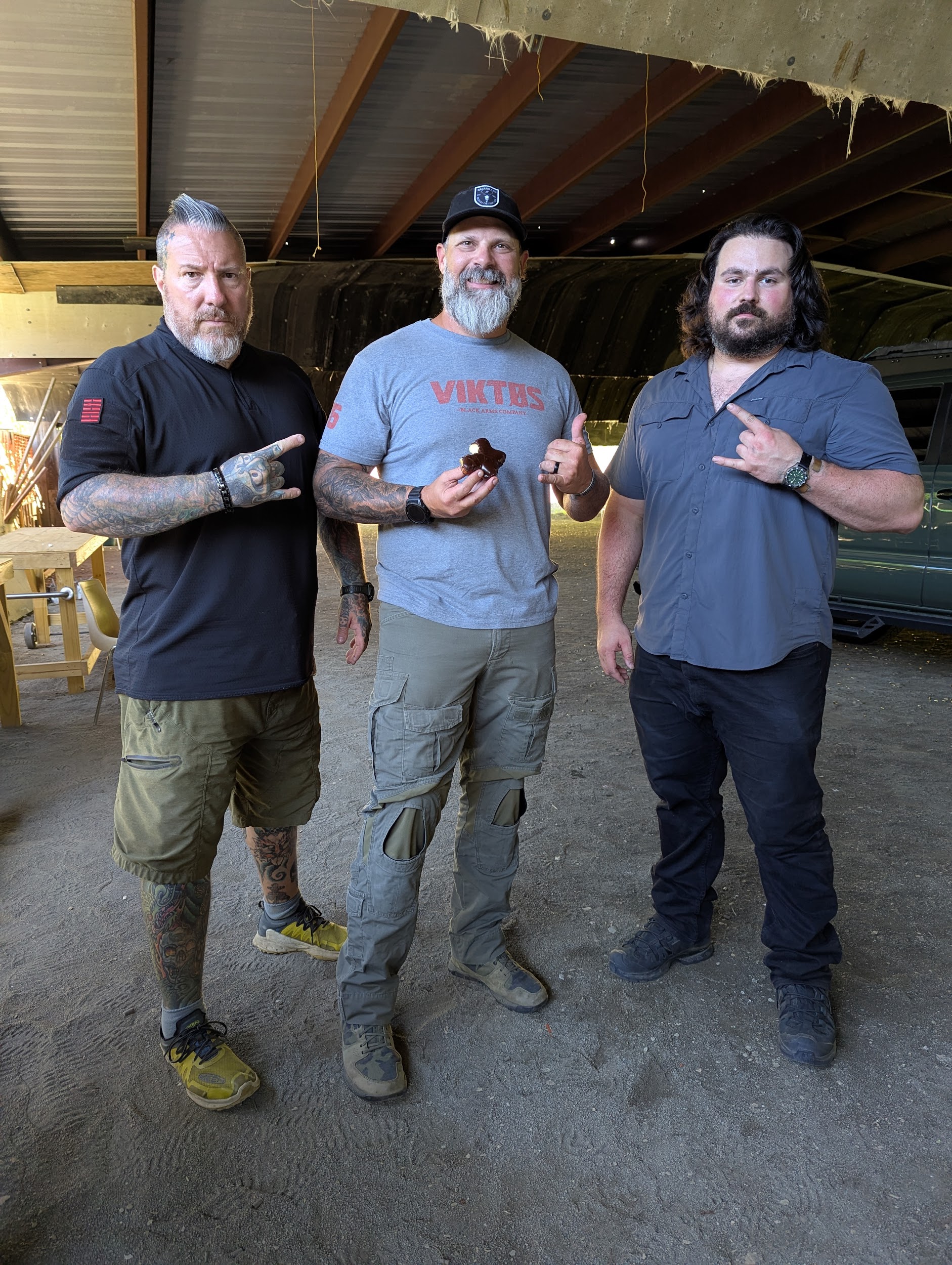
Seeing old friends from the industry (Jared, Ben, and Rachel) felt like seeing family, and the chatter among us reminded me that although there was a time where I felt alone, we were all seeing and thinking the same things relative to what’s been going on in our realm in the meantime; it’s nice knowing you haven’t gone crazy in solitude and are still on the same page with your people, even if I wasn’t actually left behind or forgotten as I felt like I was (for other reasons). Being in the training environment in the company of familiar faces all doing what we do together reminded me of what I love about what I do and why I do it, and made me feel a little bit like my old self again. Between this and the confidence booster in seeing what my capability was after a hiatus, the trip was well worth it.
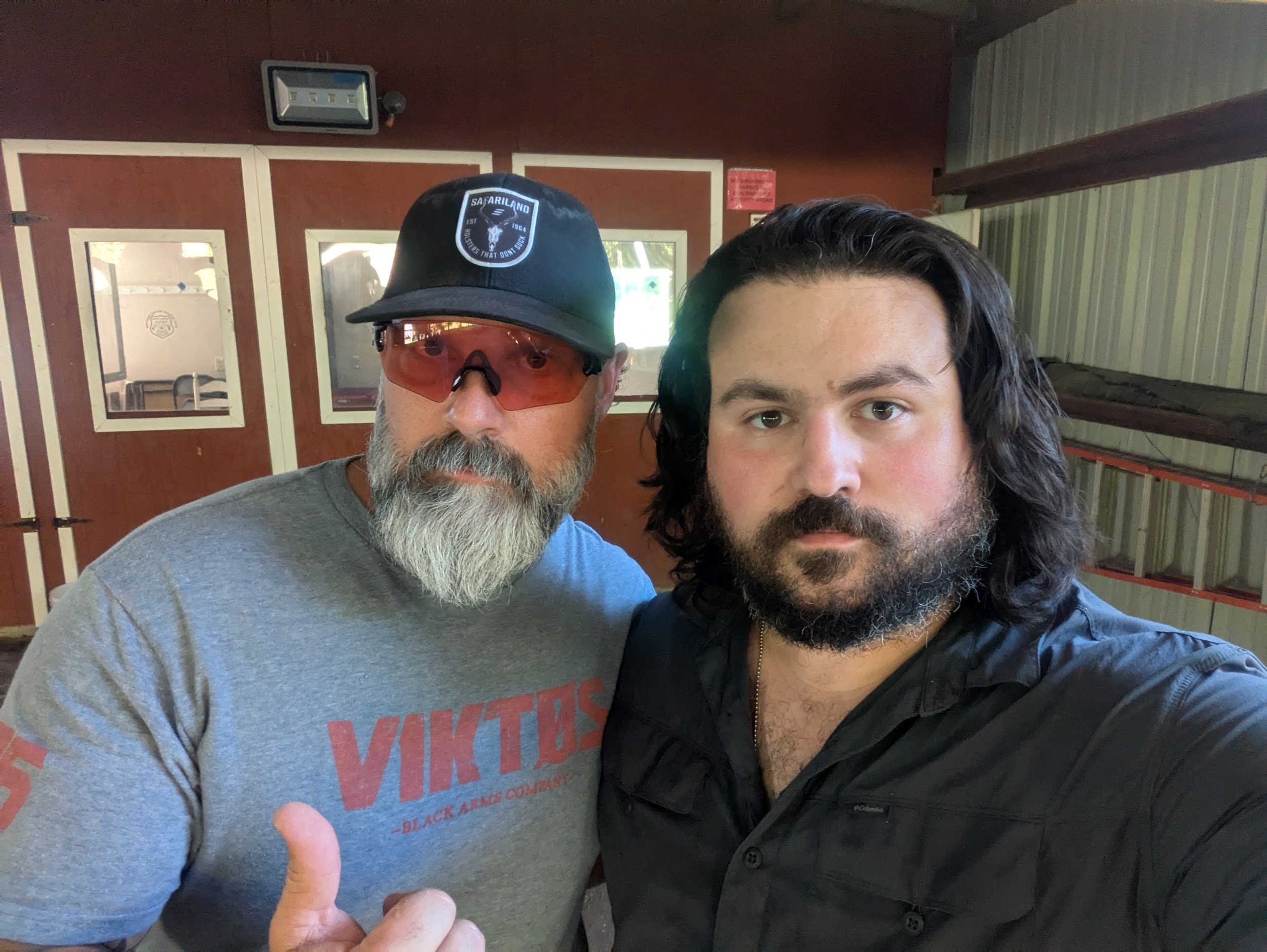
I came away from it feeling like I learned or at least better understood something than I did beforehand; Jared runs a good class and he’s not merely an instructor, he’s a teacher, and his POI is informed by rock solid experience. Then of course there’s the whole good feeling that comes from knowing you’re still shit hot on the gun and all your kit still works. All together, it was a good time, well worth the trip and the expenses thereof. I’d definitely train with Jared again if he’s back in the area to do rifle, although I might have to make the trip up to Ridgeline in NH for that; either way, a solid recommendation to train with Jared from me, don’t hesitate if you have the opportunity.
Stick around, more on the way.
Stay Dangerous.
Stay in this L.A.N.E.


